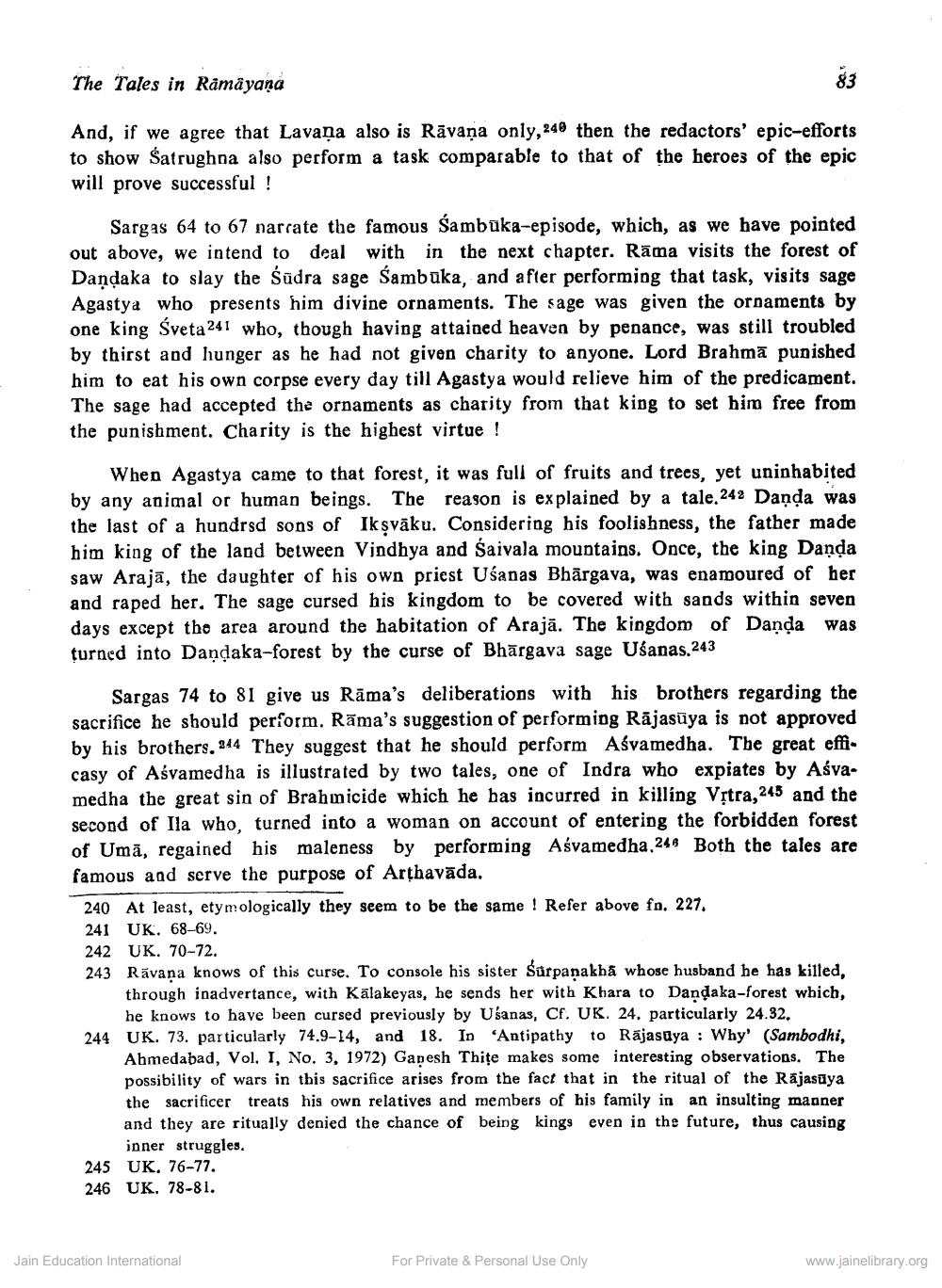________________
The Tales in Ramayana
And, if we agree that Lavaņa also is Rāvana only, 24 then the redactors' epic-efforts to show $atrughna also perform a task comparable to that of the heroes of the epic will prove successful !
Sargas 64 to 67 narrate the famous sambuka-episode, which, as we have pointed out above, we intend to deal with in the next chapter. Rāma visits the forest of Dandaka to slay the Śūdra sage Sambūka, and after performing that task, visits sage Agastya who presents him divine ornaments. The sage was given the ornaments by one king Sveta 241 who, though having attained heaven by penance, was still troubled by thirst and hunger as he had not given charity to anyone. Lord Brahmā punished him to eat his own corpse every day till Agastya would relieve him of the predicament. The sage had accepted the ornaments as charity from that king to set him free from the punishment. Charity is the highest virtue !
When Agastya came to that forest, it was full of fruits and trees, yet uninhabited by any animal or human beings. The reason is explained by a tale. 242 Danda was the last of a hundrsd sons of Ik svāku. Considering his foolishness, the father made him king of the land between Vindhya and Saivala mountains. Once, the king Danda saw Arajā, the daughter of his own priest Uśanas Bhārgava, was enamoured of her and raped her. The sage cursed his kingdom to be covered with sands within seven days except the area around the habitation of Arajā. The kingdom of Danda was turned into Dandaka-forest by the curse of Bhārgava sage Ušanas.243
Sargas 74 to 81 give us Rāma's deliberations with his brothers regarding the sacrifice he should perform. Rāma's suggestion of performing Rājasüya is not approved by his brothers. 244 They suggest that he should perform Aśvamedha. The great efficasy of Aśvamedha is illustrated by two tales, one of Indra who expiates by Aśva. medha the great sin of Brahmicide which he has incurred in killing Vstra, 245 and the second of Ila who, turned into a woman on account of entering the forbidden forest of Umā, regained his maleness by performing Aśvamedha,246 Both the tales are famous and serve the purpose of Arthavāda. 240 At least, etymologically they seem to be the same ! Refer above fn. 227. 241 UK. 68-69. 242 UK. 70-72. 243 Rāvana knows of this curse. To console his sister Sürpanakha whose husband he has killed,
through inadvertance, with Kalakeyas, he sends her with Khara to Dandaka-forest which,
he knows to have been cursed previously by Uśanas, Cf. UK, 24. particularly 24.32. 244 UK. 73. particularly 74.9-14, and 18. In 'Antipathy to Rajasuya : Why' (Sambodhi,
Ahmedabad, Vol. I, No. 3, 1972) Ganesh Thițe makes some interesting observations. The possibility of wars in this sacrifice arises from the fact that in the ritual of the Rajasūya the sacrificer treats his own relatives and members of his family in an insulting manner and they are ritually denied the chance of being kings even in the future, thus causing
inner struggles. 245 UK. 76-77. 246 UK, 78-81.
Jain Education International
For Private & Personal Use Only
www.jainelibrary.org




